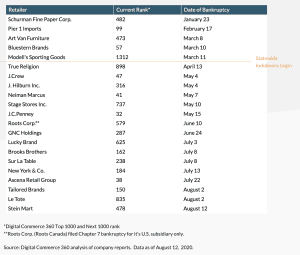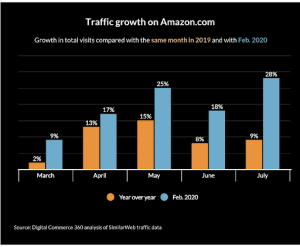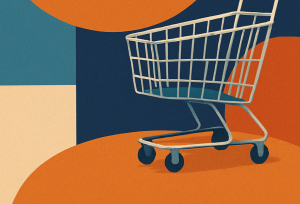
Share
I think by now we’re all aware on the surface-level that lockdowns and restrictions by governments in most parts of the world due to the spread of Coronavirus (aka COVID-19) have had a huge impact on our lives and economies.
Particularly, we’ve covered pretty extensively at Advertise Purple the ways in which it has impacted how people shop for things they need. Being in the business of e-commerce, this dictates the strategies we utilize for our clients.
Of course, there’s been a major shift towards online shopping, but that alone is no longer all that newsworthy. It’s obvious too that brick and mortar locations are struggling and in some cases shutting down.
What’s a little bit less obvious is that what’s happening right now due to the virus’ spread may lead to lasting changes we’ll look back on as stemming from what’s happening right now.
We wanted to share some data with you today to help prepare you for a future, either with coronavirus under control or finally eradicated. We’ll also point out some data that substantiates our argument that developing a multi-faceted affiliate strategy right now is well worth it.
Let’s dive right into what those are.
1. Having a robust e-commerce strategy will no longer be optional
In the first six months of the year, consumers spent $347.26 billion online with U.S. retailers, up 30.1% from $266.84 billion for the same period in 2019, according to the latest Digital Commerce 360 analysis of U.S. Department of Commerce data.
Comparatively, e-commerce sales during the first half of 2019 grew just 12.7% year over year. Online spending represented 18.6% of total retail sales for the first two quarters of 2020.
Takeaway: Coronavirus sped up what many of us in digital marketing knew was already happening: a major shift towards e-commerce by consumers across all industries and verticals. Also, we’ve witnessed our own customers’ success particularly with the affiliate channel.
Again, this shouldn’t be a major shock but it’s important to point it out first and foremost.
2. Retailers went bankrupt in record numbers, some of which did so even prior to the mandatory lockdowns, making them less desirable to brands
21 North American retailers filed for bankruptcy protection thus far in 2020.17 of those retailers filed during the COVID-19 outbreak in the U.S. Lockdowns and store closures have drained revenue, pushing already-struggling companies like J.C. Penney Co. Inc., J. Crew Group Inc. and Neiman Marcus Group Inc. into bankruptcy.
Takeaway: A few years ago, getting your product featured in a brick and mortar location like one of those above would be thought of as a major win. Now, brands who’ve focused on digital marketing and e-commerce strategies only, rather than attempting to go to trade shows and do things the old fashioned way are benefitting. Of course, this is partially a shift that was already happening but Coronavirus and lockdowns sped up this shift, undoubtedly.
3. Curbside pickup will continue to be a strategy utilized by stores, even after the virus is long gone, which blends the online and IRl shopping experience
Statewide lockdowns, store closures and the fear of contracting the coronavirus have kept consumers from shopping in stores. As a result, many retailers launched curbside pickup as a way to get products to consumers safely. While this omnichannel trend has been on the rise for the past couple years, many store retailers launched curbside amid the pandemic.
As of August 2020, 43.7% of the 245 retailers with stores ranked in the Digital Commerce 360 Top 500 offer curbside pickup, a sharp increase from 6.9% at the end of 2019.
Takeaway: At first, this may seem less related to e-commerce, but the blending of digital shopping methods and in-store convenience has made a big change in the process of finding and ultimately retrieving products. People are still willing to go out to get their items, but they don’t want to leave their vehicles. This will remain true, even long after it’s safe again to be around crowds of people.
4. Amazon.com traffic is going absolutely bonkers during the pandemic, but this is true of smaller affiliates and online stores as well
Amazon.com Inc., the largest North American online retailer, continues to see increased traffic to its site even as statewide stay-at-home orders lift and stores reopen. In July, site traffic was up 28.1% compared with February 2020 and up 8.7% year over year, according to Digital Commerce 360’s analysis of traffic data from web measurement firm SimilarWeb. It’s important to note that traffic is up year over year despite Amazon postponing its annual Prime Day sales event, which was held in July 2019, to the fall in 2020.
We compared monthly traffic to the same month the previous year as well as to February 2020. This allows us to compare shopper behavior right before the pandemic hit the U.S.
Takeaway: Amazon acts as a representation of e-commerce in general here, in my mind. And while they may have the market share in e-commerce, these absurd numbers that obviously jump off the page when you see them can be extrapolated to other parts of the internet and digital sales world. Also, with Amazon slashing their rates, we think affiliate marketers have a chance to show up as an alternative way to gain market share back from this behemoth. With time, all end consumers will grow accustomed to shopping online.
—
We’re hearing so often how well e-commerce is performing right now, but we wanted to supply hard facts that indicate just that. If you have any interest in getting in on this action, please get in touch with us at [email protected]
Thank you!





